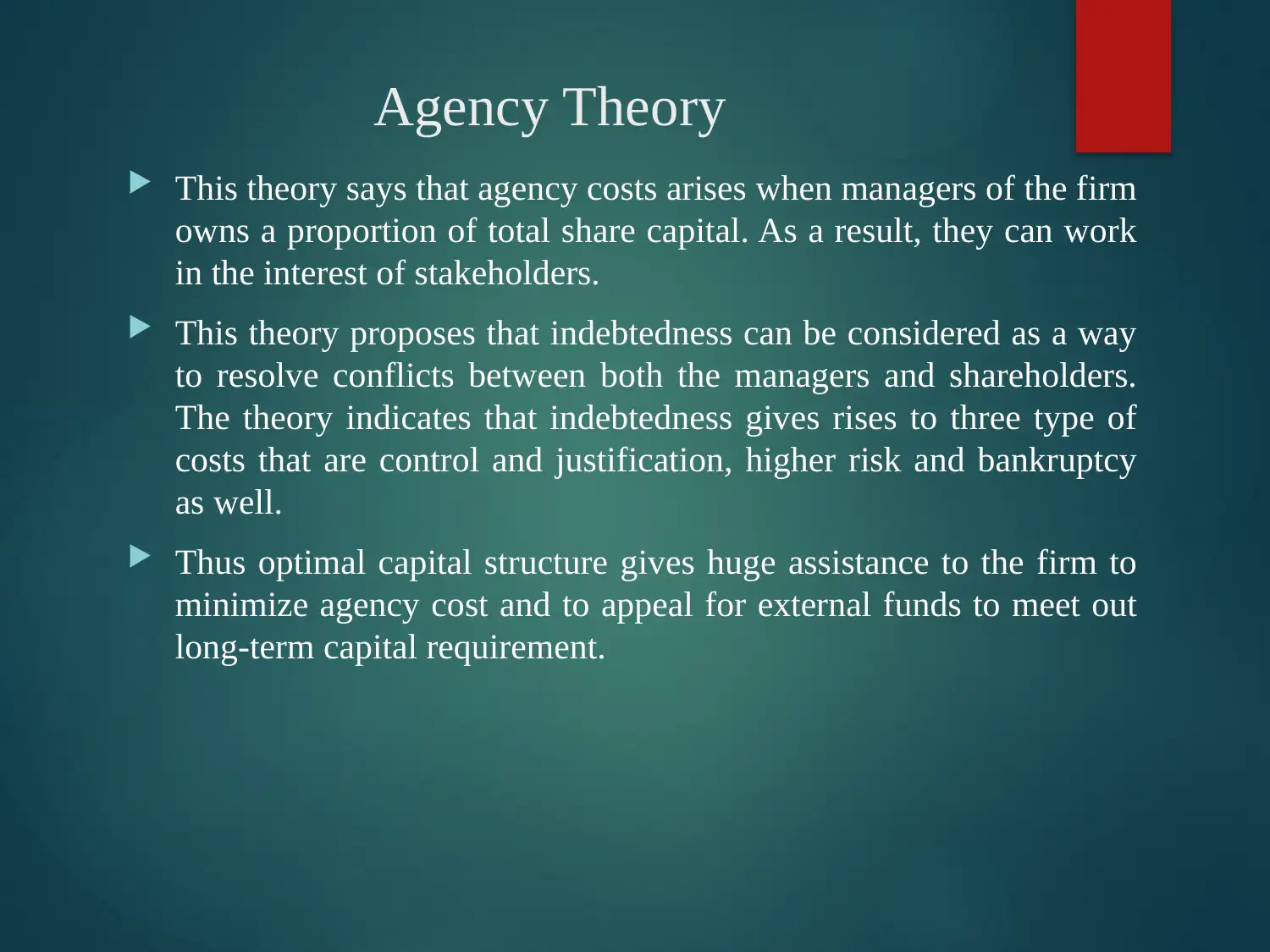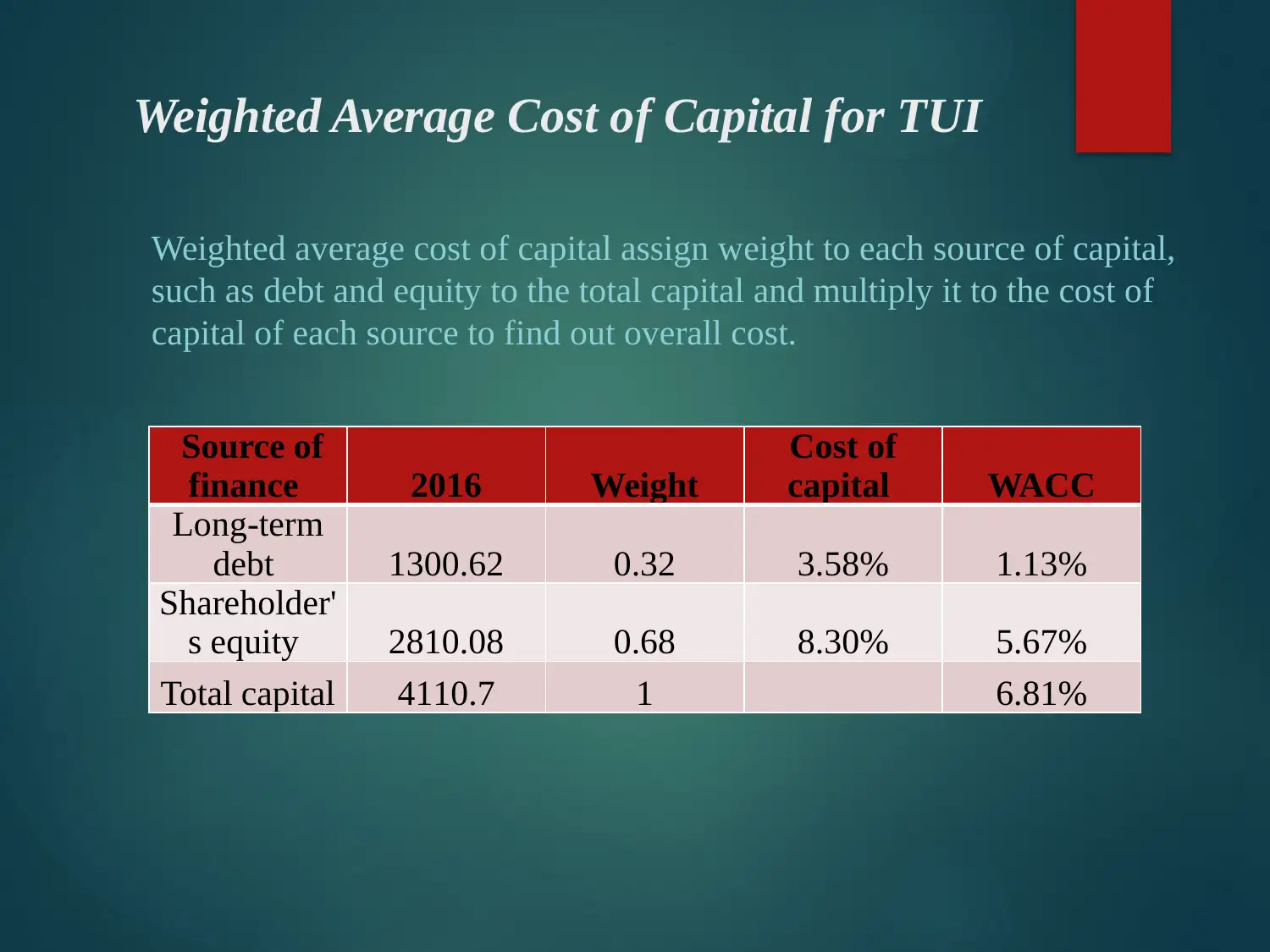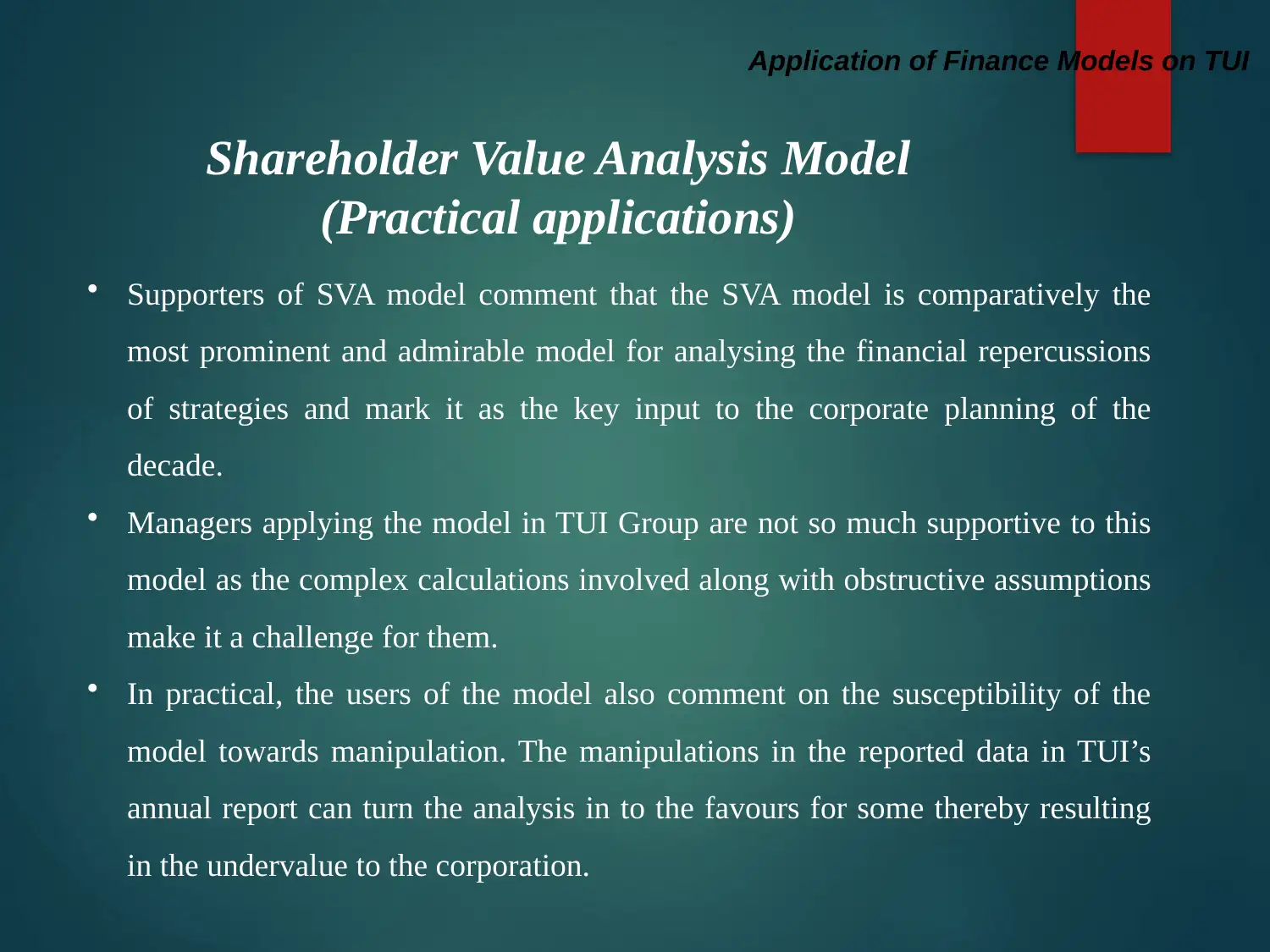Applying Finance Models: A Market Valuation Analysis of TUI Group
VerifiedAdded on 2023/04/11
|22
|1854
|56
Report
AI Summary
This report provides a comprehensive analysis of TUI Group's market valuation through the application of various financial models, including the Miller and Modigliani capital structure theorem, Pecking Order Theory, Agency Theory, Shareholder Value Analysis (SVA), and Discounted Cash Flow (DCF) model. It examines TUI's capital structure, market valuation, and shareholder value, considering factors such as debt, equity, weighted average cost of capital (WACC), sales growth, and operating profit margin. The report also includes a sensitivity analysis to assess the impact of changes in sales growth on shareholder value, ultimately concluding with a recommendation for institutional investors based on the predicted future performance and potential returns of TUI Group. Desklib provides access to this and other solved assignments for students.

Accounting and finance
Paraphrase This Document
Need a fresh take? Get an instant paraphrase of this document with our AI Paraphraser

Application of Finance Models on TUI
Preposition: 1. In the absence of taxation
• In this preposition, it has been believed that, change in leverage and mix of
debt and equity will not have any effect on firm’s value and cost of capital,
thus, capital structure is irrelevant.
• As per the theory, TUI can gathered funds either from the use of debt or equity
capital each has different benefits and shortcoming as well and each of the
investors in the market have a same access to buy or sell their holdings.
Miller and Modigliani(1958) Capital structure theorem
Preposition: 1. In the absence of taxation
• In this preposition, it has been believed that, change in leverage and mix of
debt and equity will not have any effect on firm’s value and cost of capital,
thus, capital structure is irrelevant.
• As per the theory, TUI can gathered funds either from the use of debt or equity
capital each has different benefits and shortcoming as well and each of the
investors in the market have a same access to buy or sell their holdings.
Miller and Modigliani(1958) Capital structure theorem

Preposition: 2. With the presence of taxation (Trade-
off theory)
• This theory is termed as trade-off theory, in which, it has been discovered
that debt is a cheaper financial source relatively to the cost of equity. The
reason behind this is interest paid on borrowed money is tax deductible,
therefore, it provides tax benefits to the TUI Group.
• However, such kind of benefits will not be available on equity financing as
dividend on equity capital will not give tax advantage to the company.
• Thus, on the basis of this theory, TUI Group must make use of debt capital
to a threshold point in their capital structure so as to reduce the overall cost
of capital and rise firm’s value.
• However, beyond a threshold point, if debt are increase then it gives rises
to the equity capital risk, which in turn, result in higher cost.
• Therefore, in accordance with the theory, TUI Group must makes use of
debt capital to a specified point in order to reduce WACC and maximize
shareholders value.
off theory)
• This theory is termed as trade-off theory, in which, it has been discovered
that debt is a cheaper financial source relatively to the cost of equity. The
reason behind this is interest paid on borrowed money is tax deductible,
therefore, it provides tax benefits to the TUI Group.
• However, such kind of benefits will not be available on equity financing as
dividend on equity capital will not give tax advantage to the company.
• Thus, on the basis of this theory, TUI Group must make use of debt capital
to a threshold point in their capital structure so as to reduce the overall cost
of capital and rise firm’s value.
• However, beyond a threshold point, if debt are increase then it gives rises
to the equity capital risk, which in turn, result in higher cost.
• Therefore, in accordance with the theory, TUI Group must makes use of
debt capital to a specified point in order to reduce WACC and maximize
shareholders value.
⊘ This is a preview!⊘
Do you want full access?
Subscribe today to unlock all pages.

Trusted by 1+ million students worldwide

Pecking Order Theory
It is one of the most influential theory of corporate leverage that
demonstrates that availability of asymmetric information to the
managers affects the selection of internal and external financing.
It believes that retained earnings is the most effective source of
finance because it is available at nil financial cost and have no
adverse impact. While, if they need to raise money through
external finance, then debt gains preference over equity because
share capital is more riskier and costlier because of higher
premium.
The reason behind this is debt interest is fixed and also give tax
benefits, whereas, external investors need higher return in return
for the risk undertaken.
It is one of the most influential theory of corporate leverage that
demonstrates that availability of asymmetric information to the
managers affects the selection of internal and external financing.
It believes that retained earnings is the most effective source of
finance because it is available at nil financial cost and have no
adverse impact. While, if they need to raise money through
external finance, then debt gains preference over equity because
share capital is more riskier and costlier because of higher
premium.
The reason behind this is debt interest is fixed and also give tax
benefits, whereas, external investors need higher return in return
for the risk undertaken.
Paraphrase This Document
Need a fresh take? Get an instant paraphrase of this document with our AI Paraphraser

Agency Theory
This theory says that agency costs arises when managers of the firm
owns a proportion of total share capital. As a result, they can work
in the interest of stakeholders.
This theory proposes that indebtedness can be considered as a way
to resolve conflicts between both the managers and shareholders.
The theory indicates that indebtedness gives rises to three type of
costs that are control and justification, higher risk and bankruptcy
as well.
Thus optimal capital structure gives huge assistance to the firm to
minimize agency cost and to appeal for external funds to meet out
long-term capital requirement.
This theory says that agency costs arises when managers of the firm
owns a proportion of total share capital. As a result, they can work
in the interest of stakeholders.
This theory proposes that indebtedness can be considered as a way
to resolve conflicts between both the managers and shareholders.
The theory indicates that indebtedness gives rises to three type of
costs that are control and justification, higher risk and bankruptcy
as well.
Thus optimal capital structure gives huge assistance to the firm to
minimize agency cost and to appeal for external funds to meet out
long-term capital requirement.

TUI’s capital structure
2015 (GBP
million)
2016 (GBP
million)
Long-term
debt 1218.33 1300.62
Shareholder
s equity 1781.33 2810.08
Debt to
equity 0.68 0.46
2015 (GBP
million)
2016 (GBP
million)
0
500
1000
1500
2000
2500
3000
Debt and equity
(In GB P million)
2015 (GBP
million)
2016 (GBP
million)
Long-term
debt 1218.33 1300.62
Shareholder
s equity 1781.33 2810.08
Debt to
equity 0.68 0.46
2015 (GBP
million)
2016 (GBP
million)
0
500
1000
1500
2000
2500
3000
Debt and equity
(In GB P million)
⊘ This is a preview!⊘
Do you want full access?
Subscribe today to unlock all pages.

Trusted by 1+ million students worldwide

Interpretation
• In 2016, TUI group enhanced its debt from 1218.33 to 1300.62 GBP
million by 6.75%. However, excessive additional capital
requirement has been fulfilled by issuing more share capital.
• As in 2016, it has been increased from 1781.33 to 2810.08 by
57.75% resulted in declined gearing or leverage from 0.68:1 to
0.46:1 indicates lower financial risk. But still, it is a little bit far
away from the ideal ratio of debt to equity of 0.5:1.
• Thus, on the basis of this, it can be suggested to the firm to raise
additional money through taking external borrowings via debt
capital to get more tax benefits and improved solvency.
• Moreover, it will also drive benefits of trading on equity (TOE),
under this TUI group can use debt to raise earnings for the equity
shareholders and satisfy them.
• In 2016, TUI group enhanced its debt from 1218.33 to 1300.62 GBP
million by 6.75%. However, excessive additional capital
requirement has been fulfilled by issuing more share capital.
• As in 2016, it has been increased from 1781.33 to 2810.08 by
57.75% resulted in declined gearing or leverage from 0.68:1 to
0.46:1 indicates lower financial risk. But still, it is a little bit far
away from the ideal ratio of debt to equity of 0.5:1.
• Thus, on the basis of this, it can be suggested to the firm to raise
additional money through taking external borrowings via debt
capital to get more tax benefits and improved solvency.
• Moreover, it will also drive benefits of trading on equity (TOE),
under this TUI group can use debt to raise earnings for the equity
shareholders and satisfy them.
Paraphrase This Document
Need a fresh take? Get an instant paraphrase of this document with our AI Paraphraser

Application of Finance Models on TUI
TUI’s market valuation
• Shareholder value analysis, shortened to SVA refers to the
process of examining and forecasting the affect of business
decisions over net present value (NPV) to the shareholders.
• In corporate world, this analysis is often used by the firms to
measure their ability to earn excessive over the cost of capital
(WACC).
• Thus, it provides a framework to the firms for analyzing options
so as to drive improvement in the shareholders value.
TUI’s market valuation
• Shareholder value analysis, shortened to SVA refers to the
process of examining and forecasting the affect of business
decisions over net present value (NPV) to the shareholders.
• In corporate world, this analysis is often used by the firms to
measure their ability to earn excessive over the cost of capital
(WACC).
• Thus, it provides a framework to the firms for analyzing options
so as to drive improvement in the shareholders value.

Weighted Average Cost of Capital for TUI
Weighted average cost of capital assign weight to each source of capital,
such as debt and equity to the total capital and multiply it to the cost of
capital of each source to find out overall cost.
Source of
finance 2016 Weight
Cost of
capital WACC
Long-term
debt 1300.62 0.32 3.58% 1.13%
Shareholder'
s equity 2810.08 0.68 8.30% 5.67%
Total capital 4110.7 1 6.81%
Weighted average cost of capital assign weight to each source of capital,
such as debt and equity to the total capital and multiply it to the cost of
capital of each source to find out overall cost.
Source of
finance 2016 Weight
Cost of
capital WACC
Long-term
debt 1300.62 0.32 3.58% 1.13%
Shareholder'
s equity 2810.08 0.68 8.30% 5.67%
Total capital 4110.7 1 6.81%
⊘ This is a preview!⊘
Do you want full access?
Subscribe today to unlock all pages.

Trusted by 1+ million students worldwide

Shareholders value analysis model
• SVA analysis is used by corporations to maximize their
shareholders value and in order to fulfil these aim, companies are
required to measure their key value drivers.
• Most importantly, business have to quantify the expected growth
in revenues (sales), operating profit, taxes, fixed assets, increase
in working capital and so on.
• SVA analysis is used by corporations to maximize their
shareholders value and in order to fulfil these aim, companies are
required to measure their key value drivers.
• Most importantly, business have to quantify the expected growth
in revenues (sales), operating profit, taxes, fixed assets, increase
in working capital and so on.
Paraphrase This Document
Need a fresh take? Get an instant paraphrase of this document with our AI Paraphraser

Application of Finance Models on TUI
Shareholder Value Analysis Model (Value drivers)
1 Sales growth (last year % change) 3.26% per year
Operating profit margin (5 year average) 3.89 % of sales p.a.
2 Taxes (5 year average) 20.46% of operating profit
p.a.
3 Depreciation (5 year average) 31.40% of fixed assets
4 Fixed capital investment (5 years average) 50.31% of sales p.a.
5 Incremental working capital investment (5 year average) 14.62% of sales p.a.
6 The planning horizon 10 years
7 The required rate of return (WACC calculated above) 6.81% per annum
Shareholder Value Analysis Model (Value drivers)
1 Sales growth (last year % change) 3.26% per year
Operating profit margin (5 year average) 3.89 % of sales p.a.
2 Taxes (5 year average) 20.46% of operating profit
p.a.
3 Depreciation (5 year average) 31.40% of fixed assets
4 Fixed capital investment (5 years average) 50.31% of sales p.a.
5 Incremental working capital investment (5 year average) 14.62% of sales p.a.
6 The planning horizon 10 years
7 The required rate of return (WACC calculated above) 6.81% per annum

Application of Finance Models on TUI
• Supporters of SVA model comment that the SVA model is comparatively the
most prominent and admirable model for analysing the financial repercussions
of strategies and mark it as the key input to the corporate planning of the
decade.
• Managers applying the model in TUI Group are not so much supportive to this
model as the complex calculations involved along with obstructive assumptions
make it a challenge for them.
• In practical, the users of the model also comment on the susceptibility of the
model towards manipulation. The manipulations in the reported data in TUI’s
annual report can turn the analysis in to the favours for some thereby resulting
in the undervalue to the corporation.
Shareholder Value Analysis Model
(Practical applications)
• Supporters of SVA model comment that the SVA model is comparatively the
most prominent and admirable model for analysing the financial repercussions
of strategies and mark it as the key input to the corporate planning of the
decade.
• Managers applying the model in TUI Group are not so much supportive to this
model as the complex calculations involved along with obstructive assumptions
make it a challenge for them.
• In practical, the users of the model also comment on the susceptibility of the
model towards manipulation. The manipulations in the reported data in TUI’s
annual report can turn the analysis in to the favours for some thereby resulting
in the undervalue to the corporation.
Shareholder Value Analysis Model
(Practical applications)
⊘ This is a preview!⊘
Do you want full access?
Subscribe today to unlock all pages.

Trusted by 1+ million students worldwide
1 out of 22
Related Documents
Your All-in-One AI-Powered Toolkit for Academic Success.
+13062052269
info@desklib.com
Available 24*7 on WhatsApp / Email
![[object Object]](/_next/static/media/star-bottom.7253800d.svg)
Unlock your academic potential
Copyright © 2020–2025 A2Z Services. All Rights Reserved. Developed and managed by ZUCOL.





